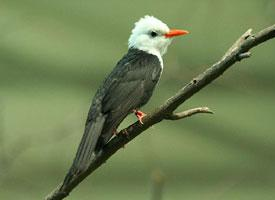
Poids et mesures
| Longueur | 18 cm |
|---|
Description de l'animal
The Common Bulbul, scientifically known as Pycnonotus barbatus, is a medium-sized passerine bird that is widely distributed across Africa. It is a member of the bulbul family, Pycnonotidae, which is known for its diverse species that inhabit various regions across the globe. The Common Bulbul is one of the most recognizable and widespread species within this family, making it a familiar sight in both urban and rural settings across its range.Physical Description:
The Common Bulbul measures approximately 18-20 cm in length and weighs around 30-45 grams. It has a distinctive appearance characterized by its dark brown or greyish-brown plumage, which contrasts sharply with its underparts that range from off-white to pale yellow. One of the most striking features of the Common Bulbul is its black head and throat, accompanied by a conspicuous white patch beneath the eye, which adds to its distinctive look. The bird's tail is long and slightly forked, with white tips on the outer feathers, which are particularly noticeable during flight. Its beak is relatively short, stout, and slightly curved downwards, adapted for its omnivorous diet. The legs and feet are strong, enabling it to forage efficiently on the ground or in trees.
Habitat and Distribution:
The Common Bulbul is highly adaptable and can be found in a wide range of habitats, from dense forests and woodlands to savannahs, farmlands, and even urban gardens and parks. Its adaptability to different environments has facilitated its wide distribution across sub-Saharan Africa, from Senegal in the west to Somalia in the east, and down to South Africa in the south. The bird's presence in diverse habitats underscores its versatility and ability to thrive in both natural and modified landscapes.
Behavior and Diet:
The Common Bulbul is an omnivore, feeding on a varied diet that includes fruits, berries, seeds, nectar, and insects. Its diet can vary seasonally and by habitat, demonstrating its flexible feeding behavior. The bird is often seen foraging in pairs or small groups, and it is not uncommon to see them feeding alongside other bird species. The Common Bulbul is also known for its vocalizations, which include a wide range of melodious calls and songs that are a common feature of its presence.
Reproduction:
The breeding season of the Common Bulbul varies by location, but it generally nests during the warmer months when food is abundant. The nest is a loose, cup-shaped structure made from twigs, grasses, and leaves, typically positioned in the fork of a tree or bush. The female usually lays 2-3 eggs, which are incubated for about 12-14 days before hatching. Both parents are involved in feeding and caring for the young, which fledge approximately 2 weeks after hatching.
Conservation Status:
Currently, the Common Bulbul is classified as Least Concern by the International Union for Conservation of Nature (IUCN), indicating that it does not face any immediate threat of extinction. Its widespread distribution and adaptability to different environments have helped maintain stable population levels. However, like many wildlife species, the Common Bulbul could be affected by habitat destruction and changes in land use. Conservation efforts aimed at preserving natural habitats and promoting biodiversity are essential for ensuring the continued survival of the Common Bulbul and countless other species that share its ecosystem.
In conclusion, the Common Bulbul is a fascinating bird that plays a vital role in its ecosystem. Its adaptability, distinctive appearance, and melodious calls make it a cherished species among birdwatchers and nature enthusiasts across Africa. As an emblem of the resilience and diversity of African avifauna, the Common Bulbul serves as a reminder of the importance of conservation efforts to protect our natural world.
Animaux similaires
Nouvelles photos d'animaux
Top 10 des animaux
- Dolphin gull (Leucophaeus scoresbii)
- Japanese macaque (Macaca fuscata)
- Greek tortoise (Testudo graeca)
- Stone loach (Barbatula barbatula)
- Galápagos tortoise (Geochelone nigra complex)
- Russian tortoise (Testudo horsfieldii)
- Diana monkey (Cercopithecus diana)
- Moustached guenon (Cercopithecus cephus)
- Common flying dragon (Draco volans)
- Galápagos penguin (Spheniscus mendiculus)
